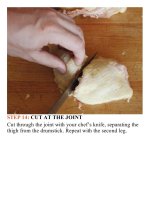The food lab better home cooking through science ( PDFDrive ) 708
Bạn đang xem bản rút gọn của tài liệu. Xem và tải ngay bản đầy đủ của tài liệu tại đây (177.6 KB, 2 trang )
HOWTOROASTABIRD
Who doesn’t love roast chicken? Crackly, crisp, salty skin.
Moist,tendermeat.Deeparomasfillingthehouse.Littlebits
offatandmeattotearoffwithyourfingersorteethasyou
lingeroverthelastsipsofyourwhiskey(whiskeygoeswith
chicken,right?).It’saboutasclassyandclassicasfoodcan
get,andmygo-tomealforcompanyortherarequietnight
inwiththewifeanddog.
But, to be perfectly frank, most of the time, Idon’t like
roast chicken, because most of the time, well, chicken, just
isn’t roasted very well. The problem is one I’m sure
everyone of you has experienced: dry breast meat and it
doesn’t just apply to chicken—we’ve all also experienced
dryturkey).I’mnottalkingaboutthekindthatfraysaround
theedgesassoonasacarvingknifecomesclosetoitorthat
instantly turns to sawdust when it hits your tongue; I’m
talking the kind that is just good enough that you can still
smileandsaynicethingsduringdinner,butjustbadenough
thatyouwonderwhythePilgrimscouldn’thaveeatenprime
ribduringthatfirstfall.
The problem, as we all know, is with overcooking. So
first, let’s take a quick look at what happens to chicken
breastmeatasitcooks:
• Under 120°F: The meat is still considered raw. Muscle
cells are bundled up and aligned in long, straight cablelike fibrils wrapped in sheaths of elastic connective
tissues,whicharewhatgivesmeatits“grain.”
• At 120°F: The protein myosin begins to coagulate,
forcing some liquid out of the muscle cells, which then
collectswithintheproteinsheaths.
•At140°F:Theremainingproteinswithinthemusclecells
coagulate,forcingalloftheliquidoutofthecellsandinto
theproteinsheaths.Thecoagulatedproteinsturnthemeat
firm and opaque. I like my chicken and turkey breasts
cookedto140°F.
•At150°F:Theproteinsinthesheathsthemselves(mainly
collagen)rapidlycoagulateandcontract.Allthewaterthat
wasforcedoutofthecellsandcollectedwithinthesheaths
is now squeezed out of the meat completely. Despite
governmentwarningstobesuretocookchickento165°F,
in reality, above 150°F or so, muscle fibershave become
almost completely squeezed dry.Congratulations, your
dinnerisnowofficiallycardboard.
On the other hand, leg meat must be cooked to at least
170°F. OK, that’s a bit of an overstatement. It’ll still be
perfectly edible at around 160°F (any lower than that, and
the abundant connective tissue will remain tough), but the
juiceswillstillbepinkorredandthemeatwillnothaveyet
reached optimal tenderness. Unlike breast meat, leg meat
contains plenty of collagen. Given a high-enough
temperature(say160°Fandabove)andalong-enoughtime
(say the 10 minutes it takes the legs to get from 160° to
170°F), the collagen will begin to convert into rich gelatin,
keeping the meat moist and juicy even after the muscle
fibershaveshedmostoftheirliquid.
So, the question is, how do you cook legs to 170°F
without taking the breasts beyond 145°F? I use three
differentmethods,dependingonthesituationandthebirdat









